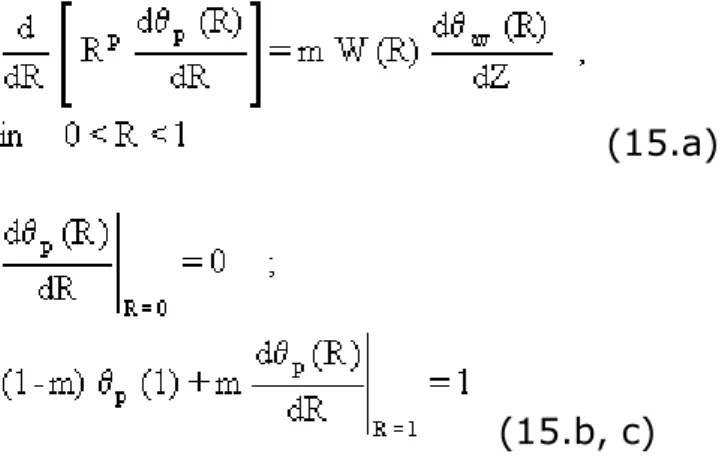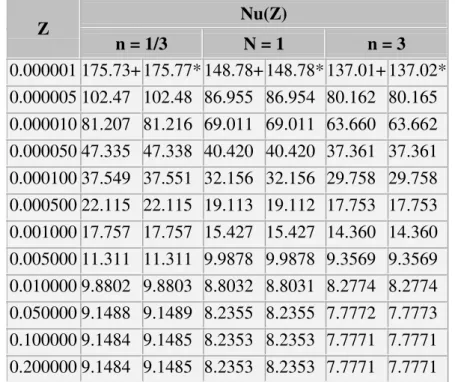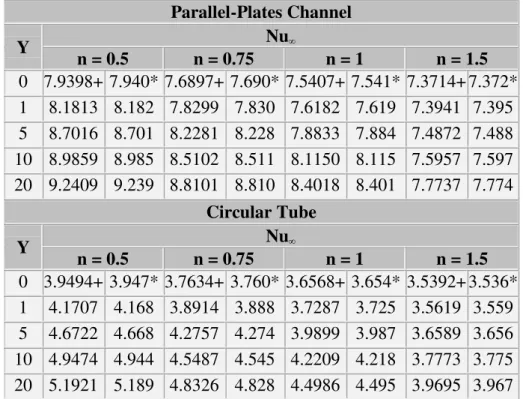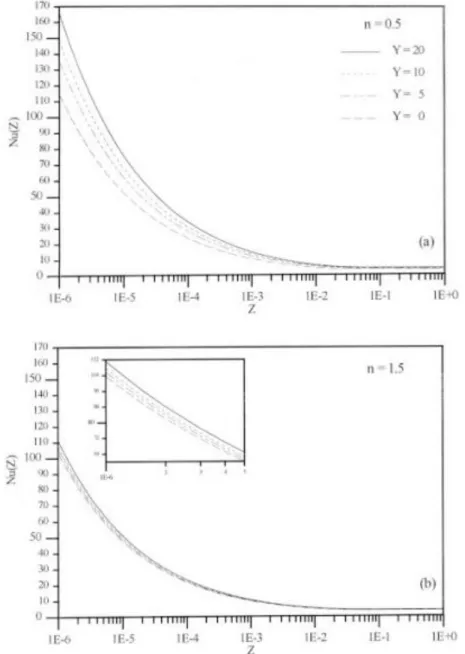INTEGRAL TRANSFORM SOLUTION FOR THE FORCED
CONVECTION OF HERSCHEL-BULKLEY FLUIDS IN
CIRCULAR TUBES AND PARALLEL-PLATES DUCTS
J. N. N. QUARESMA1 and E. N. MACÊDO2
1
Chemical Engineering Department - CT - Universidade Federal do Pará - UFPA, Campus Universitário do Guamá, Rua Augusto Corrêa,
01 - 66075-900, Belém, PA, Brazil. e-mail: quaresma@marajo.ufpa.br
2Mechanical Engineering Department - CT - Universidade Federal do
Pará - UFPA, Campus Universitário do Guamá, Rua Augusto Corrêa, 01 - 66075-900, Belém, PA, Brazil
(Received: July 6, 1997; Accepted: February 17, 1998)
Abstract - The thermal entry region in laminar forced convection of Herschel-Bulkley fluids is solved analytically through the integral transform technique, for both circular and parallel-plates ducts, which are maintained at a
prescribed wall temperature or at a prescribed wall heat flux. The local Nusselt numbers are obtained with high accuracy in both developing and fully-developed thermal regions, and critical comparisons with previously reported numerical results are performed.
Keywords: Integral transform technique, internal forced convection, Herschel-Bulkley fluids.
INTRODUCTION
The analysis of convection heat transfer to non-newtonian fluids inside ducts is of great importance in the design of thermal
rheological properties are sensitive to the temperature. Therefore, the determination of the temperature distributions in such fluids are necessary for the complete control of these properties during the drilling operation.
Thus, in this context, the present work deals with the thermal problem in both the entry and fully-developed regions of fluids that follow the Herschel-Bulkley model, inside circular and parallel-plates ducts. The solution of this problem is obtained by applying the
integral transform technique.
The analytic solution in the thermal entry region for both laminar and turbulent forced convection inside ducts involves difficulties due to the related auxiliary eigenvalue problem (Özisik et al., 1989).
Previous works have employed purely numerical techniques to solve the eigenvalue problem (Sellars et al., 1956; Shibani and Özisik, 1977), such as the Runge-Kutta method, but only the first few
eigenvalues can be determined by this technique. Consequently, it is not feasible to calculate heat transfer results in regions which are very close to the duct inlet because a large number of eigenvalues are needed for the computation of the series expansion based on the eigenfunctions.
Alternatively, numerical methods as finite-difference schemes have been employed to solve the complete system of partial differential equations, but accurate results were not obtained by these numerical schemes (Forrest and Wilkinson, 1973; Lin and Shah, 1978; Nouar et al., 1994; Mendes and Naccache, 1995).
In the 80’s, Mikhailov and Vulchanov (1983) and Mikhailov and Özisik (1984) advanced the so-called Sign-Count Method based on the approaches of Wittrick and Williams (1971, 1974), in order to solve the related Sturm-Liouville type eigenvalue problem, which permits the automatic and .highly
accurately .determination .of .as .many
eigenvalues .and.eigenfunctions .as are needed.
More recently, Cotta (1993) and Mikhailov and Cotta (1994), also developed an approach to solve eigenvalue problems based on the ideas of Generalized Integral Transform Technique (GITT) which was demonstrated to be as efficient and safe as the sign-count method.
present work, aimed at establishing benchmark results for this problem.
ANALYSIS
The rheological behavior of the non-newtonian fluid described here is given by the Herschel-Bulkley model in the following form:
(1.a)
(1.b)
where, is the shear stress, is the yield stress, is the shear rate, K is the consistency index of the fluid and n is the power-law exponent which is less than unity for pseudoplastic fluids (shear thinning materials) and greater than unity for dilatant fluids (shear thickening materials).
For the fully-developed region of a circular or a parallel-plates duct, the momentum equation in the axial coordinate z, is simplified to yield:
, (2.a)
in 0 < r < b, z > 0
subjected to the following boundary conditions
(2.b)
(2.c)
where the exponent p denotes the channel geometry and is written as:
(3.a, b)
Then, introducing equations (1) in equation (2.a), noting
(4.a)
and,
(4.b)
where bo represents the radius of the plug-flow region defined as:
(5)
The velocity profile given by equations (4) for a Herschel-Bulkley fluid
is split in two distinct regions, one for which denotes the
plug-flow region where , and the fluid behaves like a solid plug, and
another region for where , and refers to that part of the fluid which is in shear flow (Forrest and Wilkinson, 1973).
In the analysis of the thermal problem, we consider steady-state laminar forced convection heat transfer to hydrodynamically
developed flow in the thermal entry region of an incompressible non-newtonian fluid that follows the Herschel-Bulkley model, described by equations (1) and (4), inside both circular and parallel-plates ducts maintained at a prescribed wall temperature Tw, or at a prescribed
wall heat flux qw. The fluid enters the channels with a constant
uniform temperature To.
Then, the mathematical formulation of this heat transfer problem in dimensionless form is defined by:
(6.a)
subjected to the boundary and inlet conditions:
;
(6.b, c)
(6.d)
where in the boundary conditions (6.c), the coefficient m identifies whether the duct wall is subjected to a prescribed temperature or to a prescribed heat flux, in the following form:
(7.a, b)
In equations (6) above the following dimensionless groups were used:
(8.a-g)
where Dh is the hydraulic diameter, defined as:
The velocity profile given by equations (4) is written in dimensionless form by introducing the groups (8), or:
(10.a)
and,
(10.b)
where the additional groups employed in the above equations are Ro (the dimensionless radius of the plug-flow region), Y (the yield
number) and f (the Fanning friction factor), i. e.,
(11.a-c)
The Fanning friction factor and the dimensionless radius of the plug-flow region are functions of the Reynolds and yield numbers. The determination of both quantities is obtained by resolution of a simple transcendental equation, and due to space limitations is not described here. Table 1 below shows some results for the product f Re.
The problem given by equations (6) can be solved by the classical integral transform technique (Mikhailov and Özisik, 1984; Cotta, 1993). In order to make the boundary conditions (6.c) homogeneous, so as to obtain a better computational performance in the series expansion, a splitting-up procedure is proposed as (Mikhailov, 1977; Mikhailov and Özisik, 1984):
(12)
(13)
and, for the case of a prescribed wall heat flux, when we have all boundary conditions of the second kind, the average temperature is given a priori in the form:
(14)
Table 1: Product f Re computed from the present analysis
Yield Parallel–Plates Channel Circular Tube
number f Re f Re
Y n = 0.5 n = 0.75 n = 1 n = 1.5 n = 0.5 n = 0.75 n = 1 n = 1.5
0 8.00000 13.9552 24.0000 69.6745 6.32455 10.1023 16.0000 39.7175
1 10.6139 16.7855 26.9945 72.8860 8.79215 12.6895 18.6659 42.4731
5 20.3899 27.5582 38.6656 85.8155 18.1880 22.7189 29.1995 53.5825
10 31.9097 40.2208 52.5515 101.836 29.3964 34.7020 41.9439 67.4775
20 54.0525 64.2640 78.8535 132.929 51.1030 57.7230 66.4215 94.7670
Now, introducing equation (12) into equations (6), the following
problems for the potentials and are obtained:
(15.a)
(15.b, c)
(16)
and,
(17.a)
with initial and boundary conditions:
(17.b)
(17.c, d)
The homogeneous problem defined above by equations (17) can also be solved by the classical integral transform technique. Then,
following the procedures of this technique, the appropriate eigenvalue problem needed for its solution is given by:
(18.a)
where and are, respectively, the eigenfunctions and
eigenvalues. The eigenvalue problem allows for the development of the
following integral transform pair:
, (19.a,b)
where the normalization integral is given by:
(20)
Then, taking the integral transform of the system given by equation
(17), these equations are operated with , and we
obtain the following ordinary differential equation for the transformed
potential, :
(21.a)
with the transformed inlet condition given by:
(21.b)
The solution for the transformed potential given by equations (21) is readily obtained in the form:
(22)
(23)
Thus, equation(23) in conjunction with equation (16)
for complete the solution for the potential defined in equation (12). For the case of a prescribed wall heat flux, the average temperature is given by equation (14). For the case
of a prescribed wall temperature, when it isn’t determined a priori, it may be readily obtained by substituting the solution for ,
equation (12), with m = 0, into equation (13) to yield:
(24)
The local Nusselt number for both situations is defined as:
(25)
after substituting equation (12) for , and equation (24), for the case of a prescribed wall temperature, into equation (25) above, the two distinct situations result:
, (26)
for m = 0
the asymptotic Nusselt number, ,for this case, is obtained from equation (26), by considering only the first term in the summation, to yield:
(27)
, (28)
for m = 1
where, is obtained from equation (16) in the form
(29)
and in this case the asymptotic Nusselt number, , is given by equation (28), making , so that
(30)
To complete the solution it is necessary to evaluate the
eigenvalues, , the eigenfunctions and the normalization integral of the eigenvalue problem (18). Here, for instance, we have used both the sign-count method established in references (Mikhailov and Vulchanov, 1983; Mikhailov and Özisik, 1984) and the generalized integral transform technique (Cotta, 1993; Mikhailov and Cotta, 1994) to determine the eigenvalues and other related
eigenquantities necessary to compute the average temperature and the local Nusselt numbers from equations (24) and (26-30).
RESULTS AND DISCUSSION
First, the eigenvalues and other related eigenquantities were obtained by the two approaches cited above. The results obtained through the two approaches are in perfect agreement. Due to space limitations
they are not listed here. Then, the average temperature, , and the local Nusselt numbers, , were calculated.
In Tables 2.a to 2.d, the present results are validated against
results are in excellent agreement, providing a direct validation of the numerical code developed in this work.
Table 3.a shows the asymptotic Nusselt number from the present analysis and its comparison with those computed by Lin and Shah (1978) for various power-law exponents and yield numbers for both circular tubes and parallel-plates channels and considering a
prescribed wall temperature. A similar analysis is also shown in Table 3.b for the case of a prescribed wall heat flux. An excellent
agreement between the results can be observed from these tables.
Table 2.a: Local Nusselt numbers for parallel-plates channel (prescribed wall heat flux)
Z Nu(Z)
n = 1/3 N = 1 n = 3
0.000001175.73+175.77* 148.78+ 148.78* 137.01+ 137.02*
0.000005102.47 102.48 86.955 86.954 80.162 80.165
0.00001081.207 81.216 69.011 69.011 63.660 63.662
0.00005047.335 47.338 40.420 40.420 37.361 37.361
0.00010037.549 37.551 32.156 32.156 29.758 29.758
0.00050022.115 22.115 19.113 19.112 17.753 17.753
0.00100017.757 17.757 15.427 15.427 14.360 14.360
0.00500011.311 11.311 9.9878 9.9878 9.3569 9.3569
0.0100009.8802 9.8803 8.8032 8.8031 8.2774 8.2774
0.0500009.1488 9.1489 8.2355 8.2355 7.7772 7.7773
0.1000009.1484 9.1485 8.2353 8.2353 7.7771 7.7771
0.2000009.1484 9.1485 8.2353 8.2353 7.7771 7.7771
Table 2.b: Local Nusselt numbers for circular tube (prescribed wall heat flux)
Z Nu(Z)
n = 1/3 n = 1 n = 3
0.000001 147.69+ 147.72* 129.18+ 129.21* 121.61+ 121.64*
0.000005 85.882 85.891 75.180 75.191 70.796 70.806
0.000010 67.940 67.946 59.504 59.510 56.043 56.049
0.000100 31.068 31.069 27.274 27.276 25.706 25.707
0.000500 17.973 17.974 15.812 15.813 14.911 14.911
0.001000 14.239 14.239 12.538 12.538 11.824 11.824
0.005000 8.5065 8.5066 7.4936 7.4937 7.0609 7.0610
0.010000 6.9893 6.9893 6.1481 6.1481 5.7849 5.7850
0.050000 5.1947 5.1948 4.5138 4.5139 4.2098 4.2098
0.100000 5.0613 5.0613 4.3748 4.3748 4.0640 4.0640
0.200000 5.0526 5.0527 4.3637 4.3637 4.0507 4.0507
+ - Present work
* - Cotta and Ozisik (1986a)
Table 2.c: Local Nusselt numbers for parallel-plates channel (prescribed wall temperature)
Z Nu(Z)
n = 1/3 n = 1 n = 3
0.000001145.06+145.06* 122.94+ 122.94* 113.29+ 113.29*
0.00000584.465 84.466 71.830 71.830 66.284 66.284
0.00001066.887 66.887 56.999 56.999 52.643 52.643
0.00005038.901 38.901 33.379 33.379 30.915 30.915
0.00010030.826 30.827 26.560 26.560 24.642 24.642
0.00050018.126 18.127 15.830 15.830 14.767 14.767
0.00100014.566 14.566 12.822 12.822 11.999 11.999
0.0050009.4438 9.4439 8.5166 8.5166 8.0479 8.0479
0.0100008.4902 8.4902 7.7405 7.7405 7.3495 7.3495
0.0500008.2274 8.2275 7.5407 7.5407 7.1776 7.1776
0.1000008.2274 8.2275 7.5407 7.5407 7.1776 7.1776
0.2000008.2274 8.2275 7.5407 7.5407 7.1776 7.1776
Table 2.d: Local Nusselt numbers for circular tube (prescribed wall temperature)
Z Nu(Z)
n = 1/3 n = 1 n = 3
0.000001121.74+121.74* 106.54+ 106.54* 100.31+ 100.31*
0.00001055.789 55.788 48.914 48.913 46.084 46.084
0.00005032.153 32.153 28.254 28.254 26.638 26.638
0.00010025.321 25.321 22.279 22.279 21.012 21.012
0.00050014.523 14.523 12.824 12.824 12.107 12.107
0.00100011.452 11.452 10.130 10.130 9.5670 9.5670
0.0050006.7613 6.7613 6.0015 6.0015 5.6673 5.6673
0.0100005.5375 5.5375 4.9161 4.9161 4.6372 4.6372
0.0500004.2223 4.2223 3.7100 3.7100 3.4678 3.4678
0.1000004.1762 4.1762 3.6581 3.6581 3.4107 3.4107
0.2000004.1753 4.1753 3.6568 3.6568 3.4090 3.4090
+ - Present work
* - Cotta and Özisik (1986b)
Table 3.a: Asymptotic Nusselt numbers for the case of prescribed wall temperature
Parallel-Plates Channel
Y Nu
n = 0.5 n = 0.75 n = 1 n = 1.5
0 7.9398+ 7.940*7.6897+ 7.690* 7.5407+ 7.541*7.3714+7.372*
1 8.1813 8.182 7.8299 7.830 7.6182 7.619 7.3941 7.395
5 8.7016 8.701 8.2281 8.228 7.8833 7.884 7.4872 7.488
10 8.9859 8.985 8.5102 8.511 8.1150 8.115 7.5957 7.597
20 9.2409 9.239 8.8101 8.810 8.4018 8.401 7.7737 7.774
Circular Tube
Y Nu
n = 0.5 n = 0.75 n = 1 n = 1.5
0 3.9494+ 3.947*3.7634+ 3.760* 3.6568+ 3.654*3.5392+3.536*
1 4.1707 4.168 3.8914 3.888 3.7287 3.725 3.5619 3.559
5 4.6722 4.668 4.2757 4.274 3.9899 3.987 3.6589 3.656
10 4.9474 4.944 4.5487 4.545 4.2209 4.218 3.7773 3.775
20 5.1921 5.189 4.8326 4.828 4.4986 4.495 3.9695 3.967
+ - Present work *- Lin and Shah (1978)
Parallel-Plates Channel
Y Nu
n = 0.5 n = 0.75 n = 1 n = 1.5
0 8.7568+8.762* 8.4275+ 8.431*8.2353+ 8.239* 8.0201+8.024*
1 9.0739 9.080 8.6037 8.609 8.3306 8.335 8.0475 8.051
5 9.8097 9.818 9.1225 9.127 8.6611 8.666 8.1592 8.163
10 10.256 10.27 9.5155 9.522 8.9610 8.966 8.2902 8.294
20 10.693 10.71 9.9652 9.974 9.3520 9.357 8.5088 8.513
Circular Tube
Y Nu
n = 0.5 n = 0.75 n = 1 n = 1.5
0 4.7458+4.743* 4.5012+ 4.498*4.3636+ 4.362* 4.2141+4.212*
1 5.0337 5.034 4.6601 4.659 4.4510 4.449 4.2411 4.240
5 5.7474 5.789 5.1586 5.182 4.7724 4.783 4.3552 4.356
10 6.1953 6.292 5.5465 5.605 5.0727 5.107 4.4952 4.502
20 6.1953 6.292 5.5465 5.605 5.0727 5.107 4.4952 4.502
+ - Present work
* - Lin and Shah (1978)
For the case of prescribed wall heat flux in a circular duct, Figure 1 shows the evolution of the local Nusselt number as a function of the axial coordinate, Z, in the thermal entry region. The power-law
exponent here considered was n = 1 (newtonian situation) and the yield numbers were Y = 0, 5, 10 and 20. The analysis permits the comparison among the results from the present work and those obtained by Lin and Shah (1978) over the range 5x10-3 1, and those by Nouar et al. (1994) over the range of 5x10-6 10-1. From this figure only a reasonable agreement is observed between the results obtained by the two analyses, with a better agreement for increasing axial coordinate Z, i.e., only in the vicinity of the fully-developed region. Therefore, the two previous works, that have employed finite-differences schemes could not obtain numerical results with high accuracy in the thermal entry region.
In Figures 2 and 3 the local Nusselt numbers are shown in the
Figures 4 and 5 present a similar analysis for the case of a prescribed wall heat flux and the same observations are noted in relation to the parameters studied, i.e., power-law exponents, yield numbers and geometries of the channels. Finally, from these figures it is also observed that the Nusselt numbers for the case of a prescribed wall heat flux are larger than those for the case of a prescribed wall temperature.
Figure 2 - Local Nusselt number in the thermal entry region for prescribed wall temperature in a parallel-plates channel; (a) n = 0.5;
(b) n = 1.5
Figure 3 - Local Nusselt number in the thermal entry region for prescribed wall temperature in a circular tube; (a) n = 0.5; (b) n =
Figure 4 - Local Nusselt number in the thermal entry region for prescribed wall heat flux in a parallel-plates channel; (a) n = 0.5; (b)
Figure 5 - Local Nusselt number in the thermal entry region for prescribed wall heat flux in a circular tube; (a) n = 0.5; (b) n = 1.5
CONCLUSIONS
The problem of laminar convective heat transfer in the thermal entry and fully-developed flow regions of a Herschel-Bulkley fluid, for both prescribed wall temperature and prescribed wall heat flux, and for circular and parallel-plates channel, has been analyzed, with excellent computational performance, through the Integral Transform
Generalized Integral Transform Technique (GITT) approaches for the solution of the related eigenvalue problem.
Benchmark results are then tabulated and graphically presented for various power-law exponents and yield numbers.
NOMENCLATURE
b Radius of circular duct or one half the spacing between parallel-plates, m
bo Radius of plug-flow region, m
Dh Hydraulic diameter, m
f Fanning friction factor
h (z) Local heat transfer coefficient, W/m2.K k Thermal conductivity, W/m.K
K Consistency index of the fluid, N.sn/m2 m Coefficient defined in equations (7) n Power-law exponent
Ni Normalization integral
Nu (Z) Local Nusselt number Asymptotic Nusselt number
p Parameter of channel geometry or pressure Pr Prandtl number
qw Prescribed wall heat flux, W/m2
r, R Radial coordinate, dimensional and dimensionless Re Reynolds number
Ro Dimensionless radius of plug-flow region
To Inlet temperature (K)
Tw Prescribed wall temperature, K
um Average flow velocity, m/s
u(r), U(R) Velocity distribution, dimensional and dimensionless W (R) Defined by equations (8)
Y Yield number
z, Z Axial coordinate, dimensional and dimensionless
Greek Symbols
Fluid thermal diffusivity, m2/s Shear rate, s-1
Eigenvalues of problem (18)
Eigenfunctions of problem (18) Density, Kg/m3
Shear stress, N/m2
Dimensionless temperature distribution
Dimensionless average temperature
REFERENCES
Cotta, R. M., Integral Transforms in Computational Heat and Fluid Flow, CRC Press, Boca Raton (1993). [ Links ]
Cotta, R. M. and Özisik, M. N., Laminar Forced Convection to Non-Newtonian Fluids in Ducts with Prescribed Wall Heat Flux, Int. Comm. Heat Mass Transfer, 13, 325-334 (1986a). [ Links ]
Cotta, R. M. and Özisik, M. N., Laminar Forced Convection of Power-Law Non-Newtonian Fluids Inside Ducts, Wärme-und
Stoffübertragung, 20, 211-218 (1986b). [ Links ]
Forrest, G. and Wilkinson, W. L., Laminar Heat Transfer to
Temperature-Dependent Bingham Fluids in Tubes, Int. J. Heat Mass Transfer, 16, 2377-2391 (1973). [ Links ]
Lin, T. and Shah, V. L., Numerical Solution of Heat Transfer to Yield Power Law Fluids Flowing in the Entrance Region, Proc. of the
6th International Heat Transfer Conference, 5, 317-322, Toronto (1978). [ Links ]
Mendes, P. R. S. and Naccache, M. F., Heat Transfer to Herschel-Bulkley Fluids in Laminar Fully Developed Flow through Tubes, Proc. of the 13th Brazilian Congress of Mechanical Engineering, XIII COBEM, Belo Horizonte, Brazil, December (1995). [ Links ]
Mikhailov, M. D., Splitting Up of Heat-Conduction Problems, Letters Heat Mass Transf., 4, 163-166 (1977). [ Links ]
Mikhailov, M. D. and Cotta, R. M.., Integral Transform Method for Eigenvalue Problems, Comm. Num. Meth. Eng., 10, 827-835 (1994). [ Links ]
Mikhailov, M. D. and Özisik, M. N., Unified Analysis and Solutions of Heat and Mass Diffusion, John Wiley, New York (1984). [ Links ]
Mikhailov, M. D. and Vulchanov, N. L., Computational Procedure for Sturm-Liouville Problems, J. Comp. Phys., 50, 323-336
Nouar, C.; Devienne, R. and Lebouche, M., Convection Thermique pour un Fluide de Herschel-Bulkley dans la Région d’Entrée d’une Conduite, Int. J. Heat Mass Transfer, 37, 1-12 (1994). [ Links ]
Özisik, M. N.; Cotta, R. M. and Kim, W. S., Heat Transfer in Turbulent Forced Convection Between Parallel-Plates, Can. J. Chem. Eng., 67, 771-776 (1989). [ Links ]
Sellars, J. R.; Tribus, M. and Klein, J. S., Heat Transfer to Laminar Flow in a Round Tube or a Flat Conduit - The Graetz Problem Extended, Trans. Am. Soc. Mech. Eng., 78, 441-448
(1956). [ Links ]
Shibani, A. S. and Özisik, M. N., A Solution to Heat Transfer in Turbulent Flow Between Parallel Plates, Int. J. Heat Mass Transfer, 20, 565-573 (1977). [ Links ]
Wittrick, W. H. and Williams, F. W., A General Algorithm for
Computing Natural Frequencies of Elastic Structures, Quart. J. Mech. Appl. Math., 24, 263-284 (1971). [ Links ]
Wittrick, W. H. and Williams, F. W., Buckling and Vibrations of Anisotropic or Isotropic Plate Assemblies under Combined Loading, Int. J. Mech. Sci. , 16, 209-239 (1974). [ Links ]
All the contents of this journal, except where otherwise noted, is licensed under a Creative Commons Attribution License
Associação Brasileira de Engenharia Química
Rua Líbero Badaró, 152 , 11. and. 01008-903 São Paulo SP Brazil
Tel.: +55 11 3107-8747 Fax.: +55 11 3104-4649 Fax: +55 11 3104-4649






